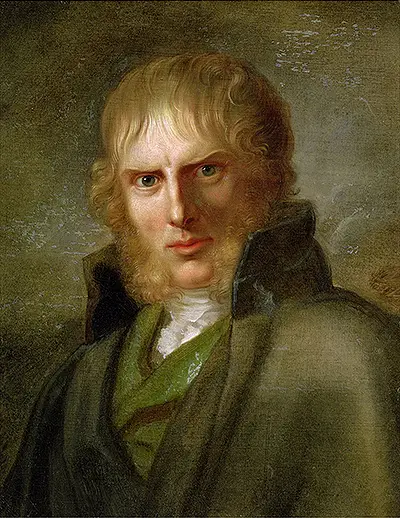Caspar David Friedrich was a highly significant German artist from the 19th century who was most famous for his work within the genre of landscape painting.
Friedrich was a German landscape painter heavily involved within the Romanticist art movement and had a long and distinguished career which produced a huge amount of high quality landscape oil paintings. Find Friedrich paintings here. The artist was truly passionate about his landscape work and this dominated his career in a similar way to that of British artists Turner and Constable.
Friedrich frequently depicted individual characters in the foreground overlooking a huge landscape scene which he would find a symbolic gesture as well as helping to add to the feeling of awe to the viewer who would get some sense of perspective. Wanderer above the Sea of Fog is certainly the best example of this approach but there were several other examples too, often using several characters together in the foreground.
Romanticism was an art movement which rose in the 19th century to become a crucial lead up to the later impressionist movement and many of the contributors to it were from Britain and France. Friedrich himself was a German artist who managed to get involved thanks to his exceptional illustrative skills and moody style that was perfectly suited to the Romanticist principles. Some of the other famous members of the Romanticist movement included Eugène Delacroix, Francisco de Goya, Théodore Géricault and Gustave Courbet.
The career highlights of Friedrich are all predominantly oil on canvas but he had a great early exposure to all sorts of different media and this was beneficial to his overall development an an artist. His strong illustration skills helped him to build oil paintings upon strong foundations, then adding further detail and colour with bold colour and carefully blended tones.
Friedrich was one of a number of artists to have found support witin Russia whilst perhaps struggling domestically. The artist developed links with several rich Russian families who became interested in his style of painting to the point of buying several art works on regular occasions, helpin the artist to fund his future work and concentrate on continuing in the style that he most enjoyed.
Friedrich did count several artists amongst his friends, with some sharing his studio at various times upon his invitation. Philipp Otto Runge was one interesting connection to Friedrich as he himself was a member of the German Romanticists and as such these two had a particularly large amount in common and could benefit from their discussions on various elements of this painting style which they were both so fond of.
It is a sad thing to consider that Friedrich suffered poor health and social separation towards his final years and it was only the Russian royal family who purchased some of his paintings to enable him to receive better care after suffering a stroke. Within his native Germany his career had deteriorated and Romanticism has become seen as a passing fashion, with little interest in those who had followed in his footsteps. Most still consider Caspar David Friedrich to be amongst the most talented and famous German artists of all time, across all art movements. Those joining him in this exclusive band of creative masters would certainly have to include the likes of Albrecht Durer, Hans Holbein, Paul Klee, Franz Marc and Ernst Ludwig Kirchner.
Wanderer Above the Sea of Fog
Wanderer Above the Sea of Fog is certainly the most famous oil painting from Caspar David Friedrich and came about in 1818, measuring an impressive 94.8 × 74.8 cm. It is now on show at the Kunsthalle Hamburg and is also his most reproduced work by a substantial distance, with occasional viewers quickly seeing the beauty of his landscape scene and finding enjoyment in the detail that is uses with a sea of fog and background mountains.
The paintings of Caspar David Friedrich have become extremely popular as reproductions across the world for the artist's many fans who have grown to love his romanticist landscape art works. The Romanticist art movement itself has grown substantially from originally simple roots as a homegrown movement from the UK and France that later drew in others from across Europe and has now become seen as an inspirational factor that helped to bring about the rise of impressionism.
Monk by Sea
Friedrich's career fell out of favour for some years after unfairly being linked to the Nazi Party of Germany who had promoted his career, amongst others, as being from an artist whose style was to be admired. Once people realised that this link was really not from the artist's own choice, and that his style should not have been tained by this fascist regime, his paintings started to regain popularity and now this link is pretty much ignored.
Tree of Crows
The early days of Friedrich were involved with fairly standard art media but oils were not really used until later on, once his reputation was starting to build and he became more sure on the type of painter that he was to become. Printmaking with etchings and designs for woodcuts dominated the earliest stages of his artistic development before he moved onto ink, watercolour and sepias and then finally settled on standard oil on canvas.
On Board a Sailing Ship
The Royal Academy in Copenhagen played host to Friedrich for several years in his twenties at a time when he was studying hard as an artist and looking for as many different influences and ideas as possible. Several interesting sketches which he produced here are now on display at the Royal Museum of Fine Arts in Copenhagen. Artist Friedrich certainly still has strong links with several other countries other than just his native Germany.




